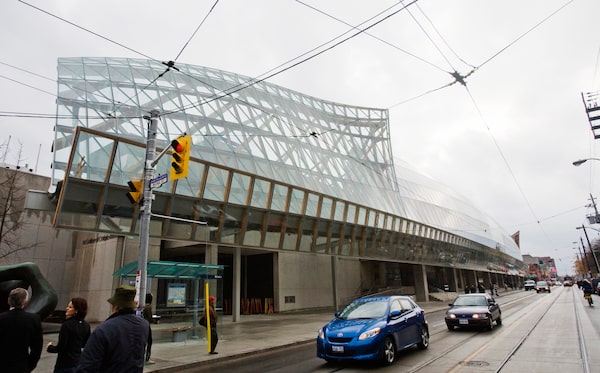
The Art Gallery of Ontario in Toronto.Mark Blinch/Reuters
The Art Gallery of Ontario, one of Canada’s largest art museums, is planning a 55,000-square-foot expansion of its building in downtown Toronto, The Globe and Mail has learned.
Dubbed “AGO Global Contemporary,” the proposed expansion would include a six-floor tower rising from the northeast corner of the building to accommodate new galleries for contemporary art. Its estimated budget is $60-million.
The gallery issued a request for proposals to potential architects. That document calls for “highly flexible and well-proportioned spaces that can accommodate the media and materials artists are working in today and tomorrow.”
The AGO is considering a tower with six floors of new gallery space. These are meant to serve the AGO’s “growing collection of global modern & contemporary art and exhibitions,” Andrea-Jo Wilson, the gallery’s manager of public relations, said in an e-mail. She said the project is “in its infancy.”
The plan is part of a larger strategic vision, Ms. Wilson said. The AGO aims “to lead global conversations from Toronto, through extraordinary collections, exhibitions and programs, by reflecting the people who live here.”
The gallery’s request-for-proposals document highlights the diversity of the AGO’s audience, and makes the argument that modern and contemporary art are driving audience growth.
The AGO is Canada’s second most-visited art museum, behind the Montreal Museum of Fine Arts.
Nicholas Metivier, a prominent Toronto gallerist, greeted news of the project with enthusiasm. “The AGO’s responsibility, I think, is to step up their game with respect to the acquisition of contemporary art,” Mr. Metivier said.
“Toronto is by far the largest art market in Canada; you could think of the AGO holding a position in Canada the way that [the Museum of Modern Art] does in the United States.”
The gallery’s previous expansion, led by architect Frank Gehry, opened in November of 2008 with 97,000 square feet of new space. That was the latest in a serious of expansions and renovations to the gallery’s downtown building. Its oldest portion is a colonial manor house dating to 1817.
The Frank Gehry addition of 2008 dramatically changed the gallery’s physical presence in the city: It added a new, curvaceous glass-and-wood wing to the front of the museum, and a tower to the back, clad in blue titanium, facing the publicly accessible Grange Park.
It’s not clear whether the new AGO Contemporary would be as visually prominent. Ms. Wilson said the proposed site is above the gallery’s loading dock and parking lot. This would place the new tower next to the Frank Gehry-designed tower – and right next to the adjacent OCAD University building, which is planning its own vertical expansion designed by Los Angeles architects Morphosis.
The proposals document calls for “clean and simple finishes such as polished concrete floors, minimal walls and modestly open ceilings,” and spaces connected to the existing gallery floors.
The AGO’s collection has grown by 20,210 works of art in the past five years, Ms. Wilson said. “The AGO needs more space to showcase these works and to create opportunities for public engagement and learning.”
Among Toronto’s two other largest contemporary-art museums, the Power Plant has no collection and the Museum of Contemporary Art Toronto’s collection, Mr. Metivier said, is relatively modest in size. “It all really lands on the steps of the AGO, in terms of collecting,” he said.
The AGO would not comment on how the project would be funded, but Mr. Metivier speculated that it would be “no problem” to raise $60-million from prominent collectors in the Toronto region.
The AGO project would be one of several art-museum expansions in the country right now. The Vancouver Art Gallery recently announced a major gift toward its new building, and the Art Gallery of Nova Scotia is in the process of designing a new, significantly expanded facility.
Sign up for The Globe’s arts and lifestyle newsletters for more news, columns and advice in your inbox.